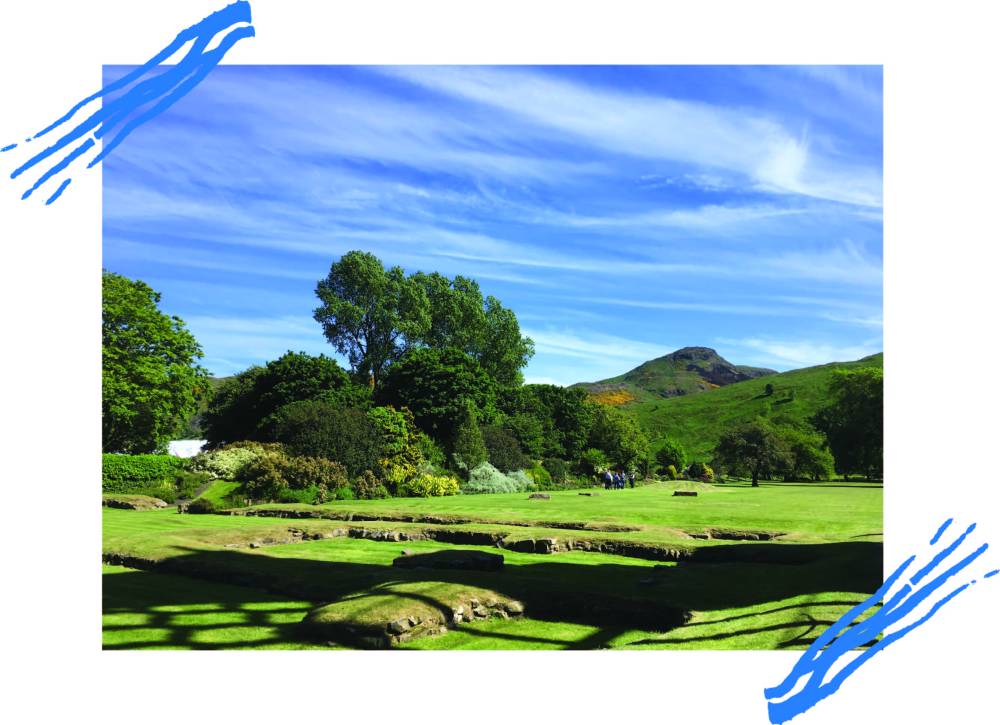This week is the Queen’s annual visit to Holyrood Palace, her official residence in Scotland. During the week she carries out a range of official engagements and ceremonies, celebrating Scottish culture, achievement and community, both meeting Scots and hosting thousands at the Palace. In honour of Holyrood Week, or as it’s known in Scotland, ‘Royal Week’, I thought I’d write about my visit to the Palace last month.
Holyrood Palace has been the principal residence for the Kings and Queens of Scotland since the 16th century and is still used for official entertaining such as Holyrood week. However, a number of the apartments, as well as the Abbey and gardens, are open to the public throughout the year.

The Palace originated from the medieval Holyrood Abbey which is rumoured to have been built by David I of Scotland in 1128 after he had a vision of a stag with a glowing cross between its antlers whilst out hunting. David took this as a message from God and built the Abbey on the same spot, the name ‘Holy Rood,’ is a reference to the ‘Holy Cross’ he saw in his vision. The small church soon expanded to form an extensive abbey, containing royal chambers, the ruins of which are still visible today.

A few centuries later, James IV decided to convert the royal chambers into a palace, celebrating his marriage to Margaret Tudor, sister of Henry VIII of England in 1503. Subsequent additions were made to the Palace, however sadly much of the building was destroyed in a fire in 1650 and much of the Palace was abandoned. Today’s Palace derives from the one built by Charles II who was restored to the throne in 1660 and began work to restore Holyrood in 1671. The new design, fronted by Sir William Bruce, effortlessly combined the old and new elements of the building and retained the plan around the courtyard. Succeeding monarchs have continued to make changes to the Palace, including Prince Albert’s development of the surrounding area and garden and George V’s modernisation such as the installation of central heating amongst other additions.

On the visit, you’re given an audio guide tour of the Palace which was a great way to take in the opulent interiors as well as learning some history about the Palace. Sadly you’re not allowed to take photos inside the Palace, so my photos are only of the outside and Abbey area, so for a glimpse inside the beautiful interiors this post talks about, take a look at the website here or visit for yourself!
The tour took you through the State Apartments, which all had beautifully intricate plasterwork ceilings and a vast collection of French and Flemish tapestries draping the walls. As with many country houses and palaces, it was interesting to see the progression of style and grandness from the first staterooms to the King’s Bedchamber. When meeting with a royalty, the monarch can choose how far along the succession of rooms you would go before meeting them; convening in the King’s Bedchamber was a sign of high status and an indication of importance. The website has a great 360 photo feature with annotations, which is a great way to find out more information about some of the objects in each room, click here to discover it.

Another interesting section of the Palace, open to the public, is the Chambers of Mary Queen of Scots, who lived in the Palace from 1561-1567. Here you can see her beautiful bedchamber with original decorative woodwork ceiling and painted frieze. I also loved the intricately embroidered curtains that surrounded the bed and covered the chairs, which can be seen on the website. Off the bedchamber, you can also visit the Supper Room, this was where Mary was dining when she witnessed the murder of her private secretary, David Rizzio who was stabbed 56 times by her jealous husband, Lord Darnley, and a group of powerful Scottish lords on 9 March 1566.
A highlight for me was seeing the Great Gallery, which is not only the area where the Queen hosts banquets, receptions and the yearly Investiture but also an amazing 95 portraits of the 95 kings (some legendary) and one queen of Scotland. There were originally 111 portraits but sadly many were damaged and destroyed in 1746 by government troops after the defeat at the battle of Falkirk. Some of the paintings still have some visible sword marks you can pick out as you walk around the room!

As well as the old abbey, the Palace has a brilliant view of Arthur’s Seat and the surrounding park.
Thanks for reading! Hope you enjoyed this quick history of Holyrood Palace, I’ll hopefully be writing about some of the other tourist sites, such as Edinburgh Castle and the Royal Yacht Britannia in the near future!


Thanks for a tour of the parts I missed 🙂
LikeLiked by 1 person
No worries at all, glad you liked the post! 🙂
LikeLike
I will be starting my series on the castles of Scotland this weekend. 🙂
LikeLiked by 1 person
Great, looking forward to it! Definitely want to visit some more castles in Scotland! ☺️
LikeLike
Getting to some of them was a bit harrowing but worth it.
LikeLiked by 1 person